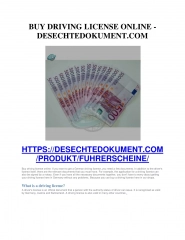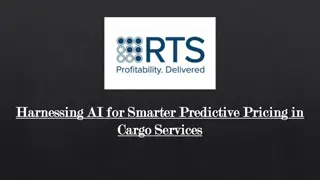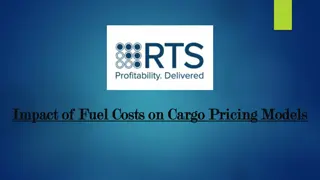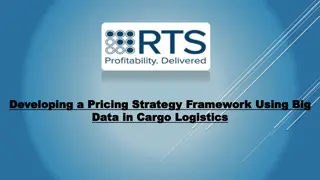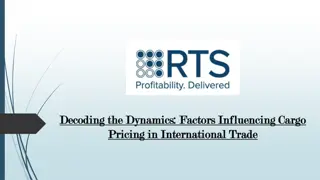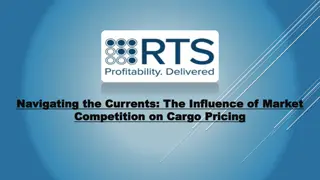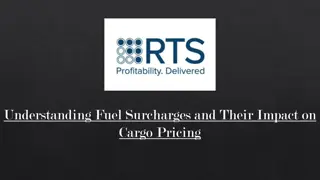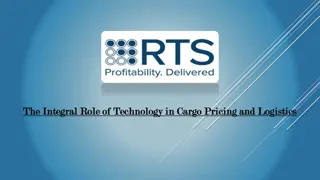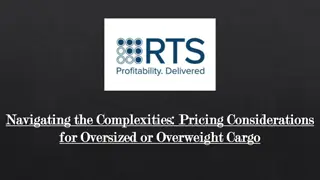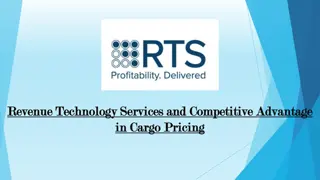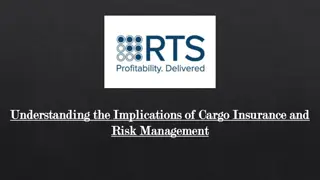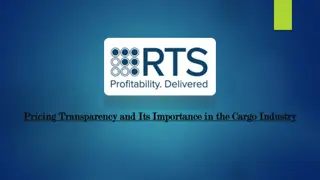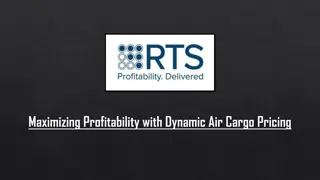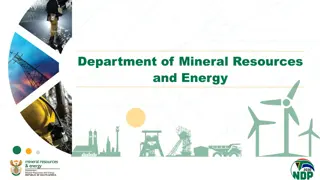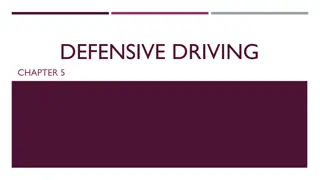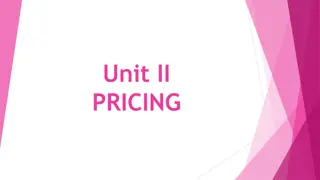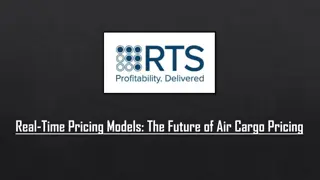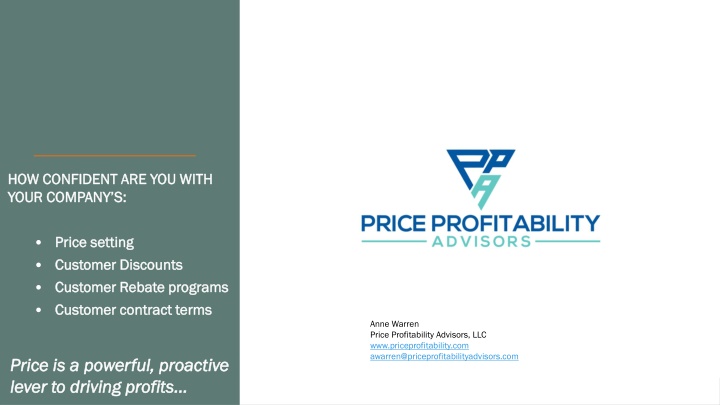
Importance of Pricing for Driving Profits & Overcoming Impediments
Understand the significance of pricing in maximizing profits through strategies like setting prices, offering discounts, implementing rebate programs, and optimizing contract terms. Learn common impediments to profit-making from pricing and how to overcome them for business success.
Download Presentation

Please find below an Image/Link to download the presentation.
The content on the website is provided AS IS for your information and personal use only. It may not be sold, licensed, or shared on other websites without obtaining consent from the author. If you encounter any issues during the download, it is possible that the publisher has removed the file from their server.
You are allowed to download the files provided on this website for personal or commercial use, subject to the condition that they are used lawfully. All files are the property of their respective owners.
The content on the website is provided AS IS for your information and personal use only. It may not be sold, licensed, or shared on other websites without obtaining consent from the author.
E N D
Presentation Transcript
HOW CONFIDENT ARE YOU WITH HOW CONFIDENT ARE YOU WITH YOUR COMPANY S: YOUR COMPANY S: Price setting Price setting Customer Discounts Customer Discounts Customer Rebate programs Customer Rebate programs Customer contract terms Customer contract terms Anne Warren Price Profitability Advisors, LLC www.priceprofitability.com awarren@priceprofitabilityadvisors.com Price is a powerful, proactive Price is a powerful, proactive lever to driving profits lever to driving profits
WHY IS PRICING SO IMPORTANT TO PROFITS? WHY IS PRICING SO IMPORTANT TO PROFITS? At a baseline of 20% EBITDA, even small improvements in price collected (aka pocket price) make significant impacts to profits As effective price per transaction increases, so does the degree of volume loss tolerated to breakeven on margin dollars Pricing is more powerful than volume, as the impact of change is Pricing is more powerful than volume, as the impact of change is 100% to profit 100% to profit PRICING IMPACT ON PROFITS 40% 35% 30% 25% 20% 15% 10% 5% 0% Baseline EBITDA level New EBITDA % % EBITDA improvement over baseline Volume loss % to breakeven (EBITDA $) 1% Increase 5% Increase 10% Increase
WHAT ARE THE COMMON IMPEDIMENTS TO ACHIEVING PROFITS FROM PRICING? WHAT ARE THE COMMON IMPEDIMENTS TO ACHIEVING PROFITS FROM PRICING? Setting Prices Discounting Rebates Contracts Focus on internal costs to set price, not value to customer Lack of definitive benchmarks for price concessions No or low standards for customer attainment Service level agreements not vetted for operational readiness, resulting in penalty/credits Inconsistent or overly complex structures, driving poor experience for both company and customer Lack of market and/or competitive insight Decentralized decision making and inability to operationally implement Unfavorable pricing terms, such as MFN (most favored nation) clauses, price locks Lack of discipline in adding features , not value Lack of preparation to more effectively negotiate with customers and procurement BY SYSTEMICALLY CHANGING THE APPROACH TO THESE FOUR KEY AREAS, BUSINESSES CAN SIGNIFICANTLY IMPROVE THEIR PROFITS BY SYSTEMICALLY CHANGING THE APPROACH TO THESE FOUR KEY AREAS, BUSINESSES CAN SIGNIFICANTLY IMPROVE THEIR PROFITS
Example Example- - Pricing Waterfall Pricing Waterfall List Price to Pocket Price/Margin Waterfall Increase Decrease Total Setting the Setting the price price $140.00 Discounting Discounting the price the price Further Further reducing the reducing the effective price effective price $125.00 $120.00 $107.00 $100.80 $(18.00) $100.00 $(5.00) $(1.20) $80.00 $60.80 $60.00 $(40.00) $40.00 20% 20% $25.00 $(35.80) $20.00 20% 20% $- List price Discounts Invoice price Rebates Other allowances Pocket price COGS Pocket margin Other costs EBITDA We can improve profit margins by improving pocket price. We focus on: We can improve profit margins by improving pocket price. We focus on: Ensuring list prices are maximized, relative to the competitive market Ensuring list prices are maximized, relative to the competitive market Making sure that discounts, rebates, and other customer allowances are aligned, based upon consistent customer criteria (size Making sure that discounts, rebates, and other customer allowances are aligned, based upon consistent customer criteria (size, u Partnering closely with both Sales and Finance teams on how to improve pocket price, and more effectively negotiate and commu Partnering closely with both Sales and Finance teams on how to improve pocket price, and more effectively negotiate and communic Building oversight processes to reduce risk in decision making,, while ensuring responsiveness to customers Building oversight processes to reduce risk in decision making,, while ensuring responsiveness to customers , unique value provided to customer, etc.) nique value provided to customer, etc.) nicate value with Procurement departments ate value with Procurement departments
Setting the Right Price To From Setting Prices Key considerations: Setting Prices Understand why customers value your brand over the competition Why are they with you today, vs. your competitors? Focus on internal costs to set price, not value to customer Product design and price setting is a collaborative exercise, and should have input from a variety of functions: Quantify the financial impact on customer operations, vs. competition- cost savings, revenue generation, etc. Lack of market and/or competitive insight Marketing/Marketing Research Engineering/Operations Sales/Technical Sales Customer Service Finance/Financial Planning and Analysis Ensure that expected distributor margins are in line with complexity of sale, along with their value add Lack of discipline in adding features , not value For new product design/price, focus on what customer problems you are trying to solve. Don t over-engineer for features that don t add value, only cost Building a formalized process aligning customer value with price is strongly recommended, along with building a financial business case with targeted financial goals Collaborate with distributors and end user customers to continuously seek solutions that are impactful to their business Ensure that Sales leaders have ability to provide Ensure that Sales leaders have ability to provide insight and input! insight and input!
Discounting Based on Rationale To From Discounting Key considerations: Discounting As discounting is often predominantly seen as a Sales function (especially within Manufacturing), it s crucial that any added governance and oversight is implemented carefully: Determine the parameters upon which concessions should or should not be made, and associated discounts. Examples: Volume Product Mix percentages Payment terms Unique packaging or other value-added services already provided to customer Lack of definitive benchmarks for price concessions Decentralized decision making and inability to operationally implement Build a RESPONSIVE process Review this process with Sales leaders FIRST, before rolling out more broadly to all of Sales Build field level authority, as well as controls to ensure that what is being approved is within guidelines, and operationally supportable within billing systems Lack of preparation to more effectively negotiate with customers and procurement For existing customers that are getting more lucrative discounts vs. new targets, work with Sales on a transition plan, vs. drastically decreasing current discounts Build an exception process with independent oversight. This is particularly important after a price increase has been implemented, to a) mitigate volume loss threats, and b) ensure price concessions aren t just automatically approved
Rebates Shift toward Reward Based Structure To From Rebates Key considerations: Rebates Similar to discounting, rebate structures and approvals are traditionally led by Sales leaders, if not Sales themselves. Align rebate amounts based upon a consistent basis of growth drivers. What behavior do you wish to incent? Volume growth/Product Mix/Revenue Growth Objective criteria for marketing program execution consistency with brand messaging No or low standards for customer attainment Inconsistent or overly complex structures, driving poor experience for both company and customer Therefore, it is important that any restructuring and added oversight is explained, and Sales leadership is comfortable articulating the value to distributor partners. Where feasible, simplify rebate structure. Where complexity is warranted, consider incorporating mechanized tracking tool, specific for rebate programs. Drastic changes in impact should be avoided, instead using a phased in approach. Ensure rebate structures that can be approved by Sales teams are operationally supportable For unique rebate programs outside of pre- approved structure, ensure a team can provide support for not only approving exceptions, but also tracking.
Contracts Focus on Reducing Risk To From Contracts Key considerations: Contracts Service level agreements not vetted for operational readiness, resulting in penalty/credits Understand the value to your customer of t&c s in your contract. T&C s can be more valuable than the price itself. Contract terms are often the most neglected aspect of pocket price, as the incorrect belief is that Legal owns the approvals. Assess and quantify financial impact of terms that have created the most sizeable risks to your business. Service level agreements with penalties are often the largest issue in the manufacturing space, along with unique billing arrangements and price lock arrangements. Unfavorable pricing terms, such as MFN (most favored nation) clauses While certainly Legal has a role in ensuring reduction of any legal risk, they are not responsible for poor business decisions. Taking a much more proactive stance toward what is being approved, and by whom, is critical to reduce risk and improve profitability. Determine which terms and conditions require more oversight, a process for risk assessment, and the key stakeholders required to approve.
Key considerations: Price Increases It s Not as Tough as You Think Plan, plan, plan. An annual price increase should be treated with no less attention than the annual budget process Objections Reality Solution Too often a price increase is done too little, too late, and with little to no planning, resulting in chaos for you and your customers. Don t let that happen to you. We ll lose volume (internal) We ll take our business elsewhere (external) No one likes a price increase, EVER. That doesn t mean they will take their business elsewhere. Do a breakeven analysis, and build a process to review escalations/customer pushback Internal communication and Internal communication and stakeholdering Marketing, Sales, Customer Service, Operations, Legal, and Finance for feedback and any contractual obligations limiting increases stakeholdering. . Include Costs aren t increasing , so we (internal) you (external) can t increase prices Costs are ALWAYS increasing, and often manufacturers are way behind in collecting for rising costs. Advance communication to customers, and professionally Advance communication to customers, and professionally written rationale written rationale. Come up with FAQ s and responses for Sales and Customer Service. Bring the discussion back to value, for example, to maintain the same great service and quality, we need to collect for increasing salaries, tight labor market, regulatory fees, taxes etc. You can also offer decreased value in their offering to maintain today s pricing. Front end Controls Front end Controls- - While advance communication is important, do not allow customers to pre-buy in excess. If unchecked, these pressures result in cost cutting measures that eat into value proposition! (Layoffs of quality control people, customer service, buying cheaper materials and impacting quality, etc.) Backend Control and Volume Loss Mitigation Backend Control and Volume Loss Mitigation- - Build a process and cadence for at risk customers, as identified by Sales and Customer Service once price increase has been announced. This process should include negotiation tactics, and a price increase concession should not be offered without gaining something in return from the customer. Without that, your credibility is greatly impacted.
Negotiation The Difference Between Customer and Procurement Procurement is the gatekeeper to push prices lower for those exact same benefits The customer is the entity receiving the benefits of your product or service Negotiation Negotiation Opportunity Opportunity
Pricing and Discounts Pricing and Discounts- - Defending Value through Negotiation Defending Value through Negotiation Understand what your unique customer values about your offer. This includes any unique elements such as expedited service, unique packaging, rebates, etc. If challenged on pricing, consider removing one of the key value drivers in exchange for a lower price, and see how they respond. Having a good, better, best service offering allows a basic segmentation strategy for different buyers, but make sure the choice is being agreed upon by not just procurement, but the ultimate customer as well. Make sure you are confident explaining the basics of the pricing to your customer. Make sure you are confident explaining the basics of the pricing to your customer. You don t need to go too deep, but having a solid understanding of market considerations, significant industry shifts, and other factors impacting the company s ability to maintain and improve customer service can help you defend the value you bring. Ensure that you and your leadership are aligned around a walk away point in the negotiation up front. Avoid the executive white knight syndrome- it hurts everyone s credibility and rewards the wrong behavior. For business that ISN T yours today, ask yourself, why are you being approached, and by whom (if it s the procurement department via an RFP, likely you are being used to put pressure on an existing vendor). By understanding motives, and ensuring an appropriate level of transparency, Sales can hold the line on the price/value tradeoffs, and still win the deal!
SMALL CHANGES IN DECISIONS DRIVE BIG RESULTS SMALL CHANGES IN DECISIONS DRIVE BIG RESULTS List Price to Pocket Price/Margin Waterfall +$1.85 +$1.85 Or 1.5% Or 1.5% increase increase Increase Decrease Total Overall: Overall: $5.05 (4%) price improvement $5.05 (4%) price improvement 18.5% improvement to EBITDA % 18.5% improvement to EBITDA % +$2.00 or 11% +$2.00 or 11% reduction reduction $140.00 +$1.00, or +$1.00, or 20% 20% improvement improvement $126.85 +20 cents, +20 cents, 17% 17% improvement improvement $120.00 $110.85 $105.85 ($16.00) ($4.00) ($1.00) $100.00 $80.00 $65.85 ($40.00) $60.00 $40.00 $30.05 ($35.80) $20.00 23.7% 23.7% $0.00 List price Discounts Invoice price Rebates Other allowances Pocket price COGS Pocket margin Other costs EBITDA Every transaction, rebate agreement and contract matters do you have insight into how your company s pricing Every transaction, rebate agreement and contract matters do you have insight into how your company s pricing decisions are made? decisions are made?
BUILDING AN INFRASTRUCTURE TO SUPPORT BETTER PRICING DECISIONS BUILDING AN INFRASTRUCTURE TO SUPPORT BETTER PRICING DECISIONS Who sets new product pricing within the organization? Who sets new product pricing within the organization? ASSESSMENT QUESTIONS ASSESSMENT QUESTIONS Who manages day to day pricing (discounts, customer Who manages day to day pricing (discounts, customer incentives, contract terms?) incentives, contract terms?) Does a pricing organization exist? Is the pricing function Does a pricing organization exist? Is the pricing function centralized or decentralized? centralized or decentralized? Is there a formalized design/price setting process for Is there a formalized design/price setting process for new products, leveraging customer & market insight? new products, leveraging customer & market insight? Does the organization consider an annual price increase Does the organization consider an annual price increase part of the companies regular activities? part of the companies regular activities? Are there formalized financial business cases Are there formalized financial business cases associated with new products? associated with new products? Organization and Corporate Culture Does the company leverage external as well as Does the company leverage external as well as internal customer insight to help set pricing? internal customer insight to help set pricing? Is there a process for evaluation of price promotions Is there a process for evaluation of price promotions and sales field authority? and sales field authority? If a governance process exists, is the process If a governance process exists, is the process mechanized with KPI s? mechanized with KPI s? Pricing Strategy and Execution Ability What is process for approval of discounts, customer What is process for approval of discounts, customer incentives, and contract terms and conditions? incentives, and contract terms and conditions? Does the company have insight into pricing by Does the company have insight into pricing by customer, by SKU, by salesperson? customer, by SKU, by salesperson? For each of these decisions/processes, is there a For each of these decisions/processes, is there a documented RACI chart? documented RACI chart? Decision Making and Processes Does the company have a financial trail from list Does the company have a financial trail from list price to pocket price? price to pocket price? Data and Tools Are price KPI s such as price, volume, and mix Are price KPI s such as price, volume, and mix variance measured and shared? variance measured and shared?

